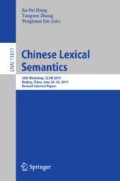Abstract
The language model based on the n-gram grammar plays an important role in NLP tasks. In this paper, language models based on language boundary are proposed to conquer the challenge of the very big language data: intra-sentence boundary model and inter-sentence boundary model. We developed a training tool on the Hadoop platform based on MapReduce programming, and conducted the prefix tree to compress and store the model. We implemented our model in identifying the boundary in the syntactic parsing, achieving a good result.
Access this chapter
Tax calculation will be finalised at checkout
Purchases are for personal use only
References
Li, Z., Sun, M.: Punctuation as implicit annotations for Chinese word segmentation. Comput. Linguist. 35(4), 505–512 (2009)
Rao, G., et al.: Natural annotation research in large-scale corpora with a focus on Chinese word segmentation. Acta Sci. Nat. Univ. Pekin. 49(1), 140–146 (2013)
Rosenfeld, R., Carbonell, J., Rudnicky, A., et al.: Adaptive statistical language modeling: a maximum entropy approach. A maximum entropy approach (1994)
Huang, X., Alleva, F., Hon, H.W., et al.: The SPHINX-II speech recognition system: an overview. Comput. Speech Lang. 7(2), 137–148 (1992)
Ney, H., Essen, U., Kneser, R.: On structuring probabilistic dependences in stochastic language modelling. Comput. Speech Lang. 8(1), 1–38 (1994)
Brown, P.F., Desouza, P.V., Mercer, R.L., et al.: Class-based n-gram models of natural language. Comput. Linguist. 18(4), 467–479 (1992)
Goodman, J.T.: A bit of progress in language modeling. Comput. Speech Lang. 15(4), 403–434 (2001)
Kuhn, R.: Speech recognition and the frequency of recently used words: a modified Markov model for natural language. In: Proceedings of ACL, pp. 348–350 (1988)
Kuhn, R., De Mori, R.: A cache-based natural language model for speech recognition. IEEE Trans. Pattern Anal. Mach. Intell. 14(6), 219–228 (1992)
Kuhn, R., Mori, R.D.: Correction to: a cache-based natural language model for speech re-production (1992)
Stolcke, A.: SRILM-an extensible language modeling toolkit. In: Interspeech, pp. 17–43 (2002)
Federico, M., Cettolo, M.: Efficient handling of n-gram language models for statistical machine translation. In: Proceedings of the 2nd WSMT, pp. 88–95. ACL (2007)
Nguyen, P., Gao, J., Mahajan, M.: MSRLM: a scalable language modeling toolkit. Microsoft Research MSR-TR-2007-144 (2007)
Zhang, R.: Research on Large Model and Its Application in Machine Translation, Ph.D thesis of Xiamen University (2009)
Zhang, Y., Hildebrand, A.S., Vogel, S.: Distributed language modeling for N-best list re-ranking. In: EMNLP, pp. 216–223 (2007)
Dean, J., Ghemawat, S.: MapReduce: simplified data processing on large clusters. Commun. ACM 51(1), 107–113 (2008)
Yu, X.: Estimating language models using Hadoop and HBase. Ph.D thesis of University of Edinburgh (2008)
Zhou, Q., Sun, M., Huang, C.: Automatic identification of Chinese maximal noun phrases. J. Softw. 11(2), 195–201 (2000)
Zhao, J., Huang, C.: Chinese basic noun phrase recognition model based on conversion. J. Chin. Inf. Process. 13(2), 1–7 (1999)
Li, H., Yang, F., Zhu, J.: Transductive HMM based text chunking. Comput. Sci. 31(2), 152–154 (2004)
Ma, Y., Liu, Y.: Base noun phrase identification based on HMM and candidates sorting by weighted templates. In: Proceedings of CCL (2005)
Liu, F., Zhao, T., Yu, H.: Statistics based Chinese chunk Parsin. J. Chin. Inf. Process. 14(6), 28–32 (2000)
Huang, D., Wang, Y.: Chunk parsing based on SVM and error-driven learning methods. J. Chin. Inf. Process. 20(6), 17–24 (2006)
Li, Y., Zhu, J., Yao, T.: Combined multiple classifiers based on a stacking algorithm and their application to Chinese text Chinese text chunking. J. Comput. Res. Dev. 42(5), 844–848 (2005)
Liu, S., Li, Y., Zhang, L.: Chinese text chunking using co-training method. J. Chin. Inf. Process. 19(3), 73–79 (2005)
Acknowledgements
This paper is supported by Research Project of National Language Committee (YBI135-90), MOE Key Research Center Project (16JJD740004) and Beijing Language and Culture University Research Project (19YJ130005).
Author information
Authors and Affiliations
Corresponding authors
Editor information
Editors and Affiliations
Rights and permissions
Copyright information
© 2020 Springer Nature Switzerland AG
About this paper
Cite this paper
Wang, Q., Rao, G., Xun, E. (2020). High Order N-gram Model Construction and Application Based on Natural Annotation. In: Hong, JF., Zhang, Y., Liu, P. (eds) Chinese Lexical Semantics. CLSW 2019. Lecture Notes in Computer Science(), vol 11831. Springer, Cham. https://doi.org/10.1007/978-3-030-38189-9_34
Download citation
DOI: https://doi.org/10.1007/978-3-030-38189-9_34
Published:
Publisher Name: Springer, Cham
Print ISBN: 978-3-030-38188-2
Online ISBN: 978-3-030-38189-9
eBook Packages: Computer ScienceComputer Science (R0)

